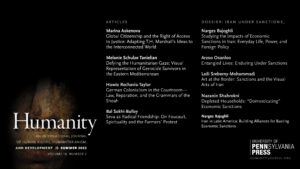The World Bank will soon be publishing its 2011 World Development Report, on “Conflict, Development, and Security.” If you want a preview of the thrust of the volume, check out theinteresting blog the Bank launched earlier this year to provide a window into the process of producing the report. (They’ve also got a Facebook page, if you’re into that sort of thing.)
Current Issue

Our long-awaited issue of Humanity journal is out! Its special dossier, Iran under Sanctions, examines the myriad and devastating impacts of international sanctions on society, culture, and politics. The issue includes an essay on the legal case Herero and Nama v. The Federal Republic of Germany to theorize reparations for German colonialism and slavery as they became linked with the aftermath of the Shoah. It also includes essays on T.H. Marshall and the right of access to justice; visual representations of Armenian genocide survivors; and, the concept of radical friendship in relation to the Farmers’ Protests in India.
View entire issue > Save Save Save
📘'Choose Your Bearing: Édouard Glissant, Human Rights and Decolonial Ethics' is now available for pre-order!
❕Grab your copy and save 30% OFF using the code NEW30 at checkout : https://edin.ac/3JIcRne
@HumanityJ
